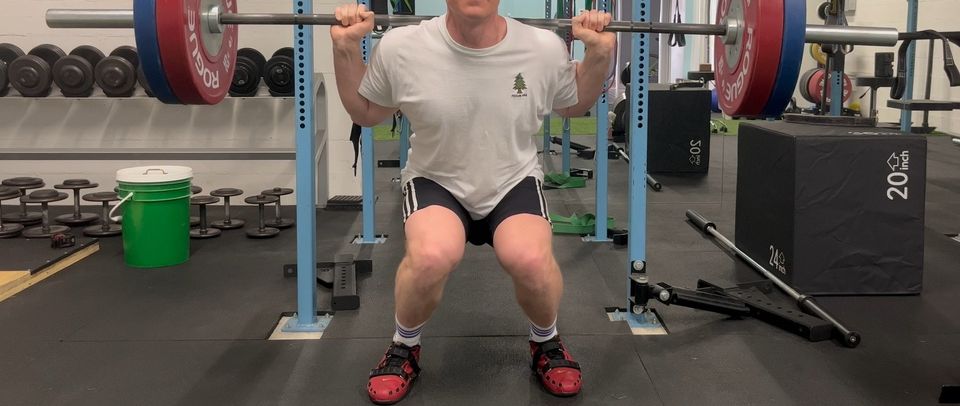It's time to stop knocking on knock knees!

Continuing with the theme of how professionals in the field like to demonize normal human movement, next we have knee valgus! You often hear people saying to ‘keep your knees out’ when they are coaching someone through a squat, or commenting that it is ugly or bad for them when their knees cave in during a squat, jump, or landing. A lot of people think it is bad, many don’t give any more reason than that and don’t articulate a point, but those that do often mention patellofemoral pain (PFP) of anterior cruciate ligament (ACL) injury. For this article I will be focusing on PFP, with a later article going over knee valgus and ACL injury. As usual, let’s dive into the research and see what is known - or unknown - about the topic.
Knee valgus, or more specifically dynamic knee valgus (DKV), is when your knees cave in when you are doing a movement like squatting, landing, jumping, etc., and people seem to think that this very common movement is bad for your knees. Practitioners and gym-goers will often try to make people afraid of this movement, with the former then selling their services to help fix the ‘problem’, mainly by strengthening the hip musculature, squatting with bands, and just trying to focus on keeping your knees out. Do these interventions actually make any difference to how your knees move? Does the fact that your knees cave in even matter?
The main target of a lot of interventions is glute/hip strength, since it is believed that weak glutes means that your knees cave in and then you get PFP. Looking at the evidence, there does seem to be a relationship between people who are currently experiencing PFP with DKV and a decrease in hip strength.1-6. I can see how this data may be, and has been, misinterpreted by many people - sadly some with very large social media following. The studies that found this relationship2-6 were cross sectional, meaning that they were only looking at one particular point in time. As Rathleff et al.1 and Rabelo & Lucareli7 pointed out, these cross sectional studies cannot show causation, thus it cannot be concluded that weak glutes cause knee pain.
Rathleff et al.1 also went on to show in their review, when looking at prospective studies (the kind that can infer causation), that there was no association between hip strength and knee pain. Basically, this is showing that PFP may be the cause of the decreased hip strength, and not the other way around. This is similar to how shoulder pain can change scapular kinematics which I discussed in a previous article. It is known that pain can lead to movement avoidance as well as muscle inhibition8 which may be an explanation for these muscle strength changes. Interestingly, when looking at runners who are in the early stages of PFP, the hip strength deficits were not present9 further suggesting that decreased hip/glute strength is not a causative factor of PFP but rather is caused by PFP, since the deficit may take time to develop. One study10 did find that large amounts of knee valgus (>10.6 degrees) increased young, female, highschool athletes’ probability of developing PFP by 30%. This study did have different findings than the other prospective studies, so it is interesting to highlight. It may highlight that large amounts of knee valgus could be a risk factor for young athletes; however, it may highlight that tolerance to the knee valgus just needs to be built up, which could mean slower individualized progression for certain activities in young athletes presenting with large amounts of DKV.
These interventions, implemented are sometimes targeted at people presenting with DKV who do not have any knee pain, based on the assumption that it is occurring because of their weak glutes. This is already shaky since we have just established that runners with early PFP don’t have glute weakness, and (surprise, surprise) there is no clear relationship between pain-free individuals with DKV and hip strength11.
Furthermore, when looking at the movement of the knee, these hip-focused interventions do not seem to have much of an impact on DKV7,12-15. Yes, the glutes get stronger, but overall it doesn’t significantly change the kinematics. This may be disheartening to some, but this is a good thing. This means that you don’t have to limit the amount of weight or intensity that you are using and can instead just focus on getting stronger and building up your tolerance to movement! You also don’t have to worry about using bands since they actually increase the amount of knee valgus during the squat16, or focus on movement control since it doesn’t change knee kinematics either17. All of this is great news since there are so many people spreading misinformation making people afraid to get into exercise by demonizing normal movement. There is no need to be afraid of how your body moves!
Also, if we take a look at muscle contributions during the barbell back squat, your adductor magnus is the main hip extensor at lighter loads and deeper squats, and has similar contributions as the gluteus maximus at heavier loads18. You read that right, a muscle that does hip extension and adduction (brings your legs in AKA creates knee valgus) plays a HUGE role in the squat. It makes biomechanical sense that your knees might cave in if one of the muscles that causes knee valgus plays a huge role in the squat.
If knee valgus is normal and doesn’t have a strong predictive factor for increasing risk of knee pain, then what might be causing your knee pain from time to time? Well, that could be attributed to tolerance, and the resulting fatigue from training19. The relative intensity of your training as well as increasing your volume of training20 have an influence on fatigue and may have some impact on injury risk19. With that being said, there are many other factors that can play a role, and trying to isolate one factor isn't productive.
Tying everything together, there is no need to be afraid of your knees coming in a bit, it is just another effective movement strategy. It is not ‘bad for your knees’ and won’t cause you pain. It’s time we throw away the idea of a perfect squat, stop calling movement ugly, and instead promote some movement optimism. Now get out there, move around and lift some weight!
- Rathleff MS, Rathleff CR, Crossley KM, Barton CJ. Is hip strength a risk factor for patellofemoral pain? A systematic review and meta-analysis. Br J Sports Med. 2014 Jul;48(14):1088. doi: 10.1136/bjsports-2013-093305. Epub 2014 Mar 31. PMID: 24687010.
- Nakagawa TH, Moriya ET, Maciel CD, Serrão FV. Trunk, pelvis, hip, and knee kinematics, hip strength, and gluteal muscle activation during a single-leg squat in males and females with and without patellofemoral pain syndrome. J Orthop Sports Phys Ther. 2012 Jun;42(6):491-501. doi: 10.2519/jospt.2012.3987. Epub 2012 Mar 8. PMID: 22402604.
- Bolgla LA, Malone TR, Umberger BR, Uhl TL. Hip strength and hip and knee kinematics during stair descent in females with and without patellofemoral pain syndrome. J Orthop Sports Phys Ther. 2008 Jan;38(1):12-8. doi: 10.2519/jospt.2008.2462. Epub 2007 Nov 21. PMID: 18349475.
- Bley AS, Correa JC, Dos Reis AC, Rabelo ND, Marchetti PH, Lucareli PR. Propulsion phase of the single leg triple hop test in women with patellofemoral pain syndrome: a biomechanical study. PLoS One. 2014 May 15;9(5):e97606. doi: 10.1371/journal.pone.0097606. PMID: 24830289; PMCID: PMC4022617.
- Souza RB, Powers CM. Differences in hip kinematics, muscle strength, and muscle activation between subjects with and without patellofemoral pain. J Orthop Sports Phys Ther. 2009 Jan;39(1):12-9. doi: 10.2519/jospt.2009.2885. PMID: 19131677.
- dos Reis AC, Correa JC, Bley AS, Rabelo ND, Fukuda TY, Lucareli PR. Kinematic and Kinetic Analysis of the Single-Leg Triple Hop Test in Women With and Without Patellofemoral Pain. J Orthop Sports Phys Ther. 2015 Oct;45(10):799-807. doi: 10.2519/jospt.2015.5011. Epub 2015 Aug 24. PMID: 26304640.
- Rabelo NDDA, Lucareli PRG. Do hip muscle weakness and dynamic knee valgus matter for the clinical evaluation and decision-making process in patients with patellofemoral pain? Braz J Phys Ther. 2018 Mar-Apr;22(2):105-109. doi: 10.1016/j.bjpt.2017.10.002. Epub 2017 Nov 8. PMID: 29157738; PMCID: PMC5883958.
- Littlewood C, Malliaras P, Bateman M, Stace R, May S, Walters S. The central nervous system--an additional consideration in 'rotator cuff tendinopathy' and a potential basis for understanding response to loaded therapeutic exercise. Man Ther. 2013 Dec;18(6):468-72. doi: 10.1016/j.math.2013.07.005. Epub 2013 Aug 6. PMID: 23932100
- Plastaras C, McCormick Z, Nguyen C, Rho M, Nack SH, Roth D, Casey E, Carneiro K, Cucchiara A, Press J, McLean J, Caldera F. Is Hip Abduction Strength Asymmetry Present in Female Runners in the Early Stages of Patellofemoral Pain Syndrome? Am J Sports Med. 2016 Jan;44(1):105-12. doi: 10.1177/0363546515611632. Epub 2015 Nov 13. PMID: 26566993.
- Holden S, Boreham C, Doherty C, Delahunt E. Two-dimensional knee valgus displacement as a predictor of patellofemoral pain in adolescent females. Scand J Med Sci Sports. 2017 Feb;27(2):188-194. doi: 10.1111/sms.12633. Epub 2015 Dec 29. PMID: 26712044.
- Dix J, Marsh S, Dingenen B, Malliaras P. The relationship between hip muscle strength and dynamic knee valgus in asymptomatic females: A systematic review. Phys Ther Sport. 2019 May;37:197-209. doi: 10.1016/j.ptsp.2018.05.015. Epub 2018 May 25. PMID: 29859898.
- Wilczyński B, Wąż P, Zorena K. Impact of Three Strengthening Exercises on Dynamic Knee Valgus and Balance with Poor Knee Control among Young Football Players: A Randomized Controlled Trial. Healthcare (Basel). 2021 May 10;9(5):558. doi: 10.3390/healthcare9050558. PMID: 34068810; PMCID: PMC8151944.
- Lopes TJA, Simic M, Myer GD, Ford KR, Hewett TE, Pappas E. The Effects of Injury Prevention Programs on the Biomechanics of Landing Tasks: A Systematic Review With Meta-analysis. Am J Sports Med. 2018 May;46(6):1492-1499. doi: 10.1177/0363546517716930. Epub 2017 Jul 31. PMID: 28759729; PMCID: PMC6604048.
- Palmer K, Hebron C, Williams JM. A randomised trial into the effect of an isolated hip abductor strengthening programme and a functional motor control programme on knee kinematics and hip muscle strength. BMC Musculoskelet Disord. 2015 May 3;16:105. doi: 10.1186/s12891-015-0563-9. PMID: 25935843; PMCID: PMC4424529.
- Ferber R, Kendall KD, Farr L. Changes in knee biomechanics after a hip-abductor strengthening protocol for runners with patellofemoral pain syndrome. J Athl Train. 2011 Mar-Apr;46(2):142-9. doi: 10.4085/1062-6050-46.2.142. PMID: 21391799; PMCID: PMC3070501.
- Reece MB, Arnold GP, Nasir S, Wang WW, Abboud R. Barbell back squat: how do resistance bands affect muscle activation and knee kinematics? BMJ Open Sport Exerc Med. 2020 Feb 4;6(1):e000610. doi: 10.1136/bmjsem-2019-000610. PMID: 32095265; PMCID: PMC7010994.
- Rabelo NDDA, Costa LOP, Lima BM, Dos Reis AC, Bley AS, Fukuda TY, Lucareli PRG. Adding motor control training to muscle strengthening did not substantially improve the effects on clinical or kinematic outcomes in women with patellofemoral pain: A randomised controlled trial. Gait Posture. 2017 Oct;58:280-286. doi: 10.1016/j.gaitpost.2017.08.018. Epub 2017 Aug 18. PMID: 28841508.
- Vigotsky, Andrew & Bryanton, Megan. (2016). Relative Muscle Contributions to Net Joint Moments in the Barbell Back Squat.
- Jones CM, Griffiths PC, Mellalieu SD. Training Load and Fatigue Marker Associations with Injury and Illness: A Systematic Review of Longitudinal Studies. Sports Med. 2017 May;47(5):943-974. doi: 10.1007/s40279-016-0619-5. PMID: 27677917; PMCID: PMC5394138.
- Hulin BT, Gabbett TJ, Lawson DW, Caputi P, Sampson JA. The acute:chronic workload ratio predicts injury: high chronic workload may decrease injury risk in elite rugby league players. Br J Sports Med. 2016 Feb;50(4):231-6. doi: 10.1136/bjsports-2015-094817. Epub 2015 Oct 28. PMID: 26511006.

Member discussion